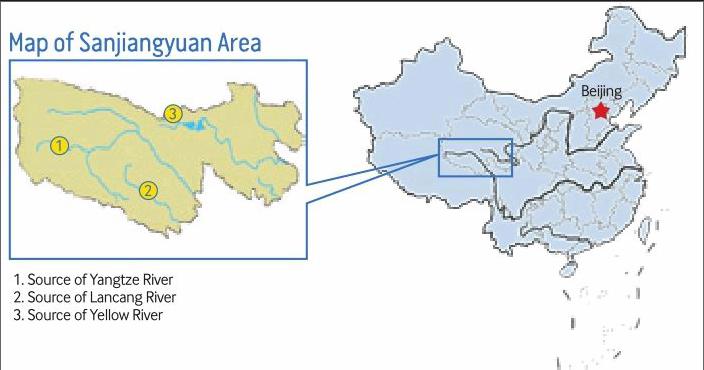Preserving The Headwaters
2014-05-09ByWangHairong
By+Wang+Hairong

The “sea of stars” is a name given to hun- dreds of lakes studding Madoi County in Golog Tibetan Autonomous Prefecture in northwest Chinas Qinghai Province. Under the sunshine, the lakes sparkle like bright stars.
Madoi, which has an average elevation of 4,500 meters, is home to a total of more than 4,000 lakes. The countys name literally means the source of the Yellow River, because water from the numerous lakes feed into the river, or the second longest waterway of China.
In the 1970s, Madoi was a rich natural location with lush grassland and abundant water. The annual average per-capita income of herders in the county was once at the top of the whole country, according to a brochure compiled by Xing Yonggui, a member of the Qinghai Provincial Writers Association.
Local residents said that in the 1960s, the grass was so tall that cattle and sheep could hide in it. In the 1980s and 1990s, Madoi went through an ecological nightmare. As a result of overgrazing and climate change, the grassland degraded, its soil was eroded, and rivers and lakes began to dry up. During this period, more than 2,000 lakes in Madoi disappeared, according to a Xinhua News Agency report.
Madoi is part of the Sanjiangyuan area, the origin of the Yangtze, Yellow and Lancang rivers. The three rivers are respectively the worlds third, fifth and sixth longest waterways.
Research shows that Sanjiangyuan supplies the Yellow, Yangtze and Lancang rivers with 49, 26 and 16 percent of their waters respectively, according to Xihai Metropolis Newspaper, a local paper in Qinghai. As a result, the area is sometimes referred to as “the water tower of China.”
In 2005, the government officially launched a large project to protect the ecological environment of Sanjiangyuan.
The project has improved Madois environment. Total lake area has swelled and the number of lakes has returned to more than 4,000, according to Xinhua.
On December 18, 2013, an executive meeting of the State Council chaired by Premier Li Keqiang adopted a plan for the second phase of the Sanjiangyuan ecological protection project.
The second phase was officially launched on January 10 and will focus on protecting and restoring vegetation. Since its commencement, the area of the Sanjiangyuan Nature Reserve has been expanded from 152,000 square km to 395,000 square km.
Li Xiaonan, Director of Qinghais Sanjiangyuan Ecological Protection and Construction Office, said that the second phase of the project, which will be ongoing until 2020, has a total budget of more than 16 billion yuan($2.58 billion).endprint
According to him, the forest coverage rate in Sanjiangyuan will be increased from 4.8 percent recorded in 2004 to 5.6 percent after the second phase is completed in 2020 and the local grassland coverage rate will rise from 25 percent to 30 percent.
Ecological recovery
During the first phase of the Sanjiangyuan ecological protection project, a total of 6.51 billion yuan ($1.05 billion) was invested in wetlands protection, converting pastures to grasslands, afforestation as well as water and soil conservation, said Wu Xiaosong, Deputy Director of the Department of Rural Economy of the National Development and Reform Commission, Chinas top economic planner.
The project increased the forest coverage rate in Sanjiangyuan from 3.2 percent in 2004 to 4.8 percent in 2012, Wu revealed. He added that during the same period, the area of wetland in the Sanjiangyuan Nature Reserve increased by 104.94 square km and the amount of conserved water grew by 2.84 billion cubic meters. The area of high coverage grassland, which is defined as land with more than half of the surface covered with grass, had also been expanding at a speed of 2,387 square km per year, according to official statistics.
These achievements could not have been made without effective conservation measures. In some instances, mountains and pastures have been closed for afforestation and rehabilitation of the grassland, and local residents have been relocated out of ecologically fragile regions.
So far, 3.78 million hectares of pastures have been closed to grazing, and 6,540 hectares of cultivated land have been converted into forests or grasslands, Li Xiaonan, the official in Qinghai, said.
Official statistics also show that a total of 55,773 residents in 10,733 households have been relocated from pastures into small cities and towns so as to protect grasslands from further degradation caused by human activities.
Most of the central and local governmentsinvestment in protecting Sanjiangyuan has been used for ecological compensation, according to Wang Jinnan, Vice President of the Chinese Academy for Environment Planning under the Ministry of Environmental Protection.
Compensation is made both to protect the environment and to improve peoples livelihoods, Wang said. For instance, residents affected by the closing of pastures are given subsidies for buying fodder for their livestock, and residents involved in converting farmland to forests or grasslands are compensated for seeds and crop yield, as well as some living costs.endprint
Residents displaced by the Sanjiangyuan ecological protection project have also received subsidies for resettlement.
The Qinghai Provincial Government has made significant efforts to establish an ecological compensation mechanism.
Over the years, it has offered vocational training to farmers and herdsmen in Sanjiangyuan, and subsidized their purchase of production materials and fuels. The provincial government has also given out tuition grants and living allowances to children of local families in the compulsory educational stage or one year prior and three years after that stage, and supported farmers and herdsmen in starting their own businesses.
Enriching local people
After moving into the towns and cities, herdsmen have to change their lifestyle.
“Living in houses is better than living in tents. It is more convenient to visit doctors and go shopping, as well as for children to go to school,” said Soibo Zhaxi, an immigrant in Madois Gyaring Township. But he also voiced concerns, saying, “For now, migrants can live on government subsidies. But what if the subsidies stop and consumer prices rise in the future?”
A sustainable ecological compensation mechanism should allow not only for the transfer of resources but the generation of new ones, said Fan Fengyu, Vice President of Changjiang and Huanghe Corp., a company that offers environmental solutions for water bodies such as the Yangtze and Yellow rivers.
In addition to fiscal transfers, Sanjiangyuan should be given help to adjust industrial structure according to the environments carrying capacity and local characteristics, Fan said.
Fan suggests that incentives should be given to local farmers and herdsmen, who are mostly Tibetans, to engage in the production of Tibet-style ornaments, animal products and Tibetan medicine.
Local farmers and herdsmen are also engaged in Sanjiangyuans ecological protection. In 2012 alone, Qinghai recruited nearly 10,000 local residents to manage and protect grasslands in the area.
From 2006, the government began to sign protection agreements with local residents, specifying their rights and responsibilities and the goals to be achieved.
Under the agreements, Tibetan herdsmen in the core zone of the Sanjiangyuan Nature Reserve can participate in patrolling, environment surveillance and animal monitoring, Ma Hongbo, a professor at Qinghai Provincial School of Administration, told Beijing-based Oriental Outlook magazine.
Wildlife in Sanjiangyuan has been effectively protected, which should be credited to governments generous investment and local residents conservation actions, said Li Xiaonan.endprint
